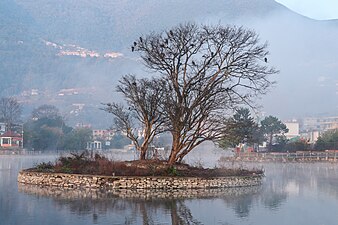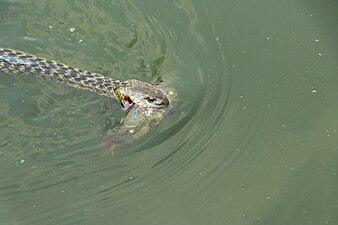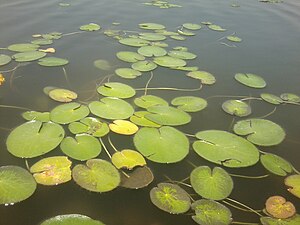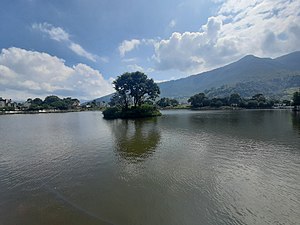
The ruddy shelduck, known in India as the Brahminy duck, is a member of the family Anatidae. It is a distinctive waterfowl, 58 to 70 cm in length with a wingspan of 110 to 135 cm. It has orange-brown body plumage with a paler head, while the tail and the flight feathers in the wings are black, contrasting with the white wing-coverts. It is a migratory bird, wintering in the Indian subcontinent and breeding in southeastern Europe and central Asia, though there are small resident populations in North Africa. It has a loud honking call.

Nal Sarovar Bird Sanctuary, consisting primarily of a 120.82-square-kilometre (46.65 sq mi) lake and ambient marshes, is situated about 64 km to the west of Ahmedabad near Sanand Village, in the Gujarat state of India. Mainly inhabited by migratory birds in winter and spring, it is the largest wetland bird sanctuary in Gujarat, and one of the largest in India. It was declared a bird sanctuary in April 1969.

Maharana Pratap Sagar, also known as Pong Reservoir or Pong Dam Lake is a large reservoir in Fatehpur, Jawali and Dehra tehsil of Kangra district of the state of Himachal Pradesh in India. It was created in 1975, by building the highest earthfill dam in India on the Beas River in the wetland zone of the Siwalik Hills. Named in the honour of Maharana Pratap (1540–1597), the reservoir or the lake is a well-known wildlife sanctuary and one of the 49 international wetland sites declared in India by the Ramsar Convention. The reservoir covers an area of 24,529 hectares, and the wetlands portion is 15,662 hectares.

Manjira wildlife sanctuary is a wildlife sanctuary and reservoir located in the Sangareddy district of Telangana State, India. Originally a crocodile sanctuary developed to protect the vulnerable species mugger crocodile, today it is home to more than 70 species of birds. The reservoir, located in the sanctuary, provides drinking water to Hyderabad and Secundarabad.

Patna Bird Sanctuary is a protected area in Uttar Pradesh's Etah district encompassing a lentic lake that is an important wintering ground for migrating birds.. It is situated near a town Jalesar which is also known as Ghungroo Nagari or Bell City. It was founded in 1991 and covers an area of 1.09 km2 (0.42 sq mi). With a lake area of only 1 km2 (0.39 sq mi), it is the smallest bird sanctuary in Uttar Pradesh.
Sur Sarovar, often referred to as Keetham Lake, is a picturesque lake off the Agra-Delhi route. The Agra Bear Rescue Facility, a facility for saving Sloth bears dedicated to rehabilitate previously captured "dancing bears," is located next to it. Since 2020, the lake has been recognised as a Ramsar site that is protected.

Marievale Bird Sanctuary is a protected area in Gauteng, South Africa. It is about 15 km2 in size, and situated on the East Rand on the southern half of the Blesbokspruit wetland, a Ramsar site. The Blesbokspruit is a major perennial river in Gauteng which is flanked by extensive floodplains on either side. Nearby is the Suikerbosrand Nature Reserve.
Singanallur Lake is a lake in Singanallur, Coimbatore, South India. It is spread over an area of 1.153 km2 (0.445 sq mi) and has an average depth of 4.25 m (13.9 ft). It is one of the 9 large lakes in the city.
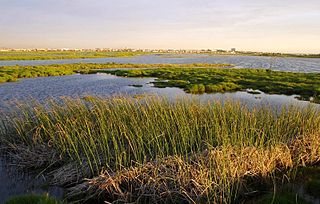
The Rietvlei Wetland Reserve is a 663-hectare (1,640-acre) nature reserve situated in Table View, Western Cape, South Africa. It is managed by the City of Cape Town's Environmental Resource Management Department.

Housing more than 200 resident and wintering bird species, Chennai has long been a haven for bird watchers. It is the one of the few urban areas in India with diverse range of birds including greater flamingo, black baza, osprey, Indian eagle-owl, Coppersmith barbet, Spot billed pelican and pied avocet can be seen. The following are some known birding hotspots in and around Chennai.
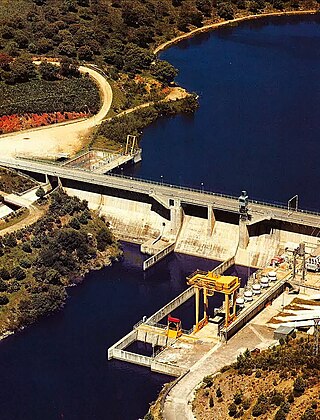
(This article is a summary translation of Spanish article Embalse de Arrocampo of Wikipedia )

Nagdaha is a lake in the Dhapakhel Village Development Committee (VDC) of Lalitpur District, in the Kathmandu Valley, Nepal.

Korattur Aeri, or Korattur Lake, also known as Vembu Pasumai Thittu, is a lake spread over 990 acres in Korattur, Chennai, India. It is located to the north of the Chennai–Arakkonam railway line. It is one of the largest lakes in the western part of the city.
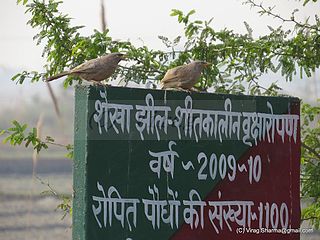
Shekha Bird Sanctuary is a bird sanctuary at a 25 ha lake near the village of Shekha, 17 km (11 mi) east of Aligarh and 5 km (3.1 mi) from the Grand Trunk Road in the state of Uttar Pradesh, India. It is notable for birding as many birds overwinter there.
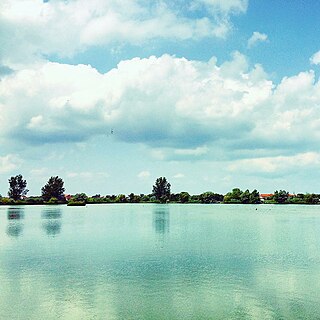
Veliko Blato is a lake in Krnjača, an urban neighborhood of Belgrade, Serbia. It is located in the municipality of Palilula.
Hail Haor Wildlife Sanctuary is a major wildlife sanctuary in Bangladesh. It is one of the most important wetlands in the Sylhet Basin for the resident and migratory waterfowls. It is also important watersource for the inhabitants living around when all other sources dry up during summer. The sanctuary is located in Moulvibazar District, in the northeast region of the country.

Nagi Bird Sanctuary is located in Jhajha Jamui district of south Bihar, near the Jharkhand border. It was declared a bird sanctuary on 25 February 1984 as per Section 18 of the Wildlife (Protection) Act, 1972. The final notification under Section 26A of the act was issued on 4 September 2009. Thousands of migrating birds congregate in the reservoir during the winter season, especially from November to February. The area of the sanctuary is 2.1 square kilometres. It is home to over 133 bird species. There are also a variety of dragonflies, damselflies and butterflies which are yet to be studied and documented. In 2004, Nagi Dam Bird Sanctuary was declared an Important Bird Area (IBA) by BirdLife International. The area overlapping with the IBA is 791 ha.

Kyzylkol is a lake in Sozak District, Turkestan Region, Kazakhstan.

Kuşcenneti National Park, established on 31 August 1959, is a national park located northeast of the Lake Kuş in Bandırma district of Balıkesir Province, northwestern Turkey.


